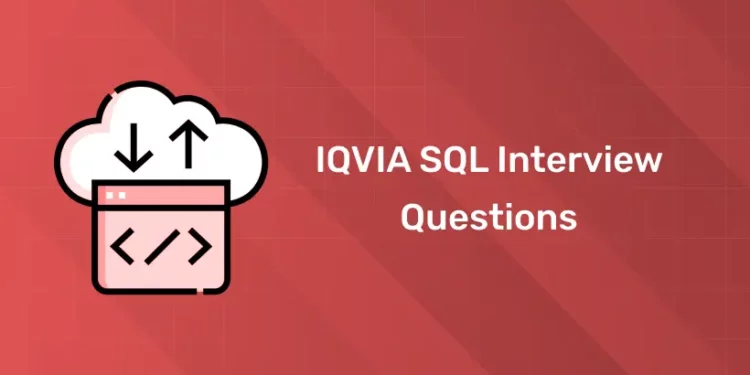Table of Contents
SQL (Structured Query Language) plays a critical role in IQVIA’s day-to-day operations, especially in managing vast amounts of healthcare data, conducting complex data analysis, and optimizing the drug development process. Whether you’re applying for a data analyst, data engineer, or database administrator role at IQVIA, having a strong command of IQVIA SQL is essential. This blog aims to guide you through the key IQVIA SQL interview questions commonly asked, helping you understand the technical expectations and preparing you to tackle both fundamental and advanced IQVIA SQL topics.
Learn Full Stack Development with expert mentors! Get Free Demo Here!
Introduction
IQVIA, often referred to as “The Human Data Science Company,” is a leading global provider of advanced analytics, technology solutions, and clinical research services to the life sciences and healthcare industries. The company leverages a combination of data, technology, and domain expertise to drive innovation in healthcare and help organizations across the globe improve patient outcomes and optimize the drug development process.
IQVIA was formed in 2016 through the merger of IMS Health and Quintiles, two prominent companies in healthcare analytics and contract research services. This merger created a powerful entity capable of offering end-to-end solutions for healthcare providers, pharmaceutical companies, and biotech firms. The company rebranded as IQVIA in 2017, combining “IQ” (intelligence quotient) and “VIA” (meaning “path” or “way”) to reflect its commitment to leveraging data and innovation to advance human health.
Core Services and Solutions
- Real-World Data (RWD) & Real-World Evidence (RWE): IQVIA collects and analyzes real-world data to provide actionable insights into patient populations, healthcare trends, and treatment outcomes. This data is crucial for healthcare providers, payers, and regulators to make informed decisions.
- Artificial Intelligence and Machine Learning (AI/ML): The company employs AI and machine learning techniques to analyze large healthcare datasets and develop predictive models. These models can be used in drug development, patient diagnosis, and healthcare optimization.
- Healthcare Technology Solutions: IQVIA develops technology platforms such as Orchestrated Customer Engagement (OCE) and the Nexxus Commercial Application Suite, which streamline various healthcare processes, from clinical trials to commercial operations.
Why Join in IQVIA?
Joining IQVIA SQL specialist can be appealing for several reasons, particularly for professionals interested in healthcare, data analytics, and technology. Here are some key reasons why people consider joining IQVIA SQL:
1. Global Leader in Healthcare and Data Analytics
- IQVIA is a global leader in providing advanced analytics, technology solutions, and contract research services to the healthcare industry. Being part of an industry leader means exposure to cutting-edge technologies and data-driven solutions in the life sciences and healthcare sectors.
2. Innovative Use of Data and Technology
- IQVIA leverages vast amounts of healthcare data, advanced analytics, artificial intelligence (AI), and machine learning to drive innovative solutions in the pharmaceutical, biotech, and healthcare industries. For data scientists, engineers, and tech professionals, it offers exciting opportunities to work on complex problems and cutting-edge projects.
3. Impact on Global Healthcare
- Working at IQVIA allows you to contribute to the improvement of global healthcare outcomes. Through research, data insights, and technology, the company helps healthcare providers and organizations optimize patient care, streamline processes, and drive innovation in medical research and treatments.
4. Diverse Career Opportunities
- IQVIA provides a wide range of roles across multiple disciplines, including clinical research, data science, healthcare consulting, project management, IT, and more. Whether you’re a researcher, analyst, or technologist, IQVIA offers diverse career paths with opportunities for growth and specialization.
5. Collaborative and Diverse Work Environment
- IQVIA fosters a collaborative work environment with a focus on diversity and inclusion. Professionals from different backgrounds, including healthcare, IT, statistics, and business, work together on projects that address critical challenges in the healthcare sector.
6. Learning and Development
- IQVIA places a strong emphasis on continuous learning and development. The company offers various learning programs, mentorship, and opportunities to advance in technical and leadership roles, making it a great place for professionals who are eager to grow and develop new skills.
7. Global Presence and Networking
- With a global presence, IQVIA offers employees the opportunity to work on international projects and collaborate with professionals from around the world. This global network enables cross-cultural learning and broadens your professional network.
8. Positive Industry Impact
- IQVIA plays a significant role in supporting drug development and clinical trials, helping pharmaceutical companies bring new and innovative treatments to market. If you’re passionate about improving patient outcomes and advancing medical research, IQVIA provides a platform to make a real impact.
9. Competitive Compensation and Benefits
- IQVIA offers competitive salary packages and a range of benefits, including health insurance, retirement plans, wellness programs, and flexible work options. It’s a stable company with a strong track record in the industry.
10. Commitment to Innovation and Ethics
-
- IQVIA is committed to innovation in healthcare while maintaining high ethical standards. Its work in supporting clinical trials, real-world evidence generation, and regulatory compliance ensures that it operates responsibly and in the best interest of patients.
Which step are you stuck on?
IQVIA SQL Interview Preparation Tips
Preparing for an SQL interview at IQVIA, or any organization focused on data-driven healthcare solutions, involves demonstrating proficiency in database management, data querying, and optimization skills. Here are some tips to help you prepare for an SQL interview at IQVIA:
1. Review SQL Basics and Fundamentals
-
-
- SQL Queries: Be well-versed in writing SQL queries for data retrieval. You should be comfortable using
SELECT,FROM,WHERE,GROUP BY,ORDER BY, andHAVING. - Joins: Understand different types of SQL joins (
INNER JOIN,LEFT JOIN,RIGHT JOIN,FULL OUTER JOIN) and how to use them to retrieve data from multiple tables. - Subqueries: Practice writing subqueries to solve complex problems. Know how to use them within
SELECT,FROM, andWHEREclauses. - Aggregate Functions: Master aggregate functions like
COUNT(),SUM(),AVG(),MIN(),MAX()to summarize data effectively. - Data Types: Know the different data types in SQL (e.g.,
INT,VARCHAR,DATE,BOOLEAN) and when to use them.
- SQL Queries: Be well-versed in writing SQL queries for data retrieval. You should be comfortable using
-
2. Understand Advanced SQL Concepts
-
-
- Window Functions: These are used extensively in data analysis. Understand how to use functions like
ROW_NUMBER(),RANK(),DENSE_RANK(), andNTILE(). These functions allow you to perform calculations across rows of a result set. - CTE (Common Table Expressions): Be familiar with CTEs for simplifying complex queries, especially recursive CTEs for hierarchical data.
- Indexes: Understand how indexes work, the different types of indexes (
B-Tree,Bitmap,Clustered,Non-clustered), and how they impact performance. - Normalization and Denormalization: Know how to design a normalized database structure and when denormalization is beneficial in query performance.
- Views and Materialized Views: Learn the differences between regular views and materialized views, and their use cases in improving query efficiency.
- Window Functions: These are used extensively in data analysis. Understand how to use functions like
-
3. Practice Query Optimization
-
-
- Execution Plans: Learn how to interpret SQL execution plans to understand how a query is executed and identify potential performance bottlenecks.
- Indexes and Optimization: Know when and how to use indexes to speed up query performance. Be able to explain the impact of indexes on read and write operations.
- Use of Limits: Practice using
LIMITorTOPto optimize queries by retrieving only the necessary data instead of the entire dataset. - Efficient Joins: Understand how to optimize joins, especially when dealing with large datasets. Be prepared to discuss how you would optimize queries using multiple joins.
-
4. Understand Database Management and Design
-
-
- Database Design: Understand the basics of database schema design, normalization rules (1NF, 2NF, 3NF, BCNF), and how to model real-world data using entity-relationship diagrams (ERD).
- Transactions and ACID Properties: Know the concepts of transactions, the ACID properties (Atomicity, Consistency, Isolation, Durability), and how they ensure the reliability of database systems.
- Locking Mechanisms: Be familiar with database locking mechanisms, deadlocks, and isolation levels to understand how concurrent transactions are managed.
- Stored Procedures and Functions: Learn how to write and optimize stored procedures, triggers, and functions, and when to use them for complex data operations.
-
5. Hands-on with Real-World Scenarios
-
-
- IQVIA may focus on real-world problems related to healthcare and life sciences, so be prepared to handle case-based questions, such as:
- How would you optimize a query for retrieving patient data across multiple healthcare providers?
- How would you manage and query large datasets in clinical trial data?
- IQVIA may focus on real-world problems related to healthcare and life sciences, so be prepared to handle case-based questions, such as:
-
6. Work on Problem-Solving and Data Interpretation
-
-
- Since IQVIA deals with healthcare data, they may expect you to interpret data results. Practice writing queries that answer specific business questions, such as:
- Querying patient data for identifying trends in medication usage.
- Extracting real-world evidence from clinical trial data.
- Analyzing large volumes of pharmaceutical sales data.
- Since IQVIA deals with healthcare data, they may expect you to interpret data results. Practice writing queries that answer specific business questions, such as:
-
7. Prepare for Behavioral and Technical Questions
-
-
- Technical Challenges: Expect technical rounds where you will be asked to write complex SQL queries, optimize existing queries, or debug queries with performance issues.
- Behavioral Questions: Prepare for behavioral interview questions around teamwork, problem-solving, and dealing with challenges. IQVIA values collaboration, so be prepared to discuss examples of how you have worked with cross-functional teams.
- Healthcare Domain Knowledge: Familiarity with the healthcare and life sciences domain may be a plus. If possible, brush up on basic healthcare data concepts, such as clinical trial datasets, patient records, and healthcare regulatory standards.
-
8. Practice with SQL Challenges Online
-
-
- Platforms like LeetCode, HackerRank, and Mode Analytics provide SQL practice challenges that simulate real interview questions. These platforms can help you get comfortable with a wide range of SQL queries and database problems.
-
9. Mock Interviews
-
-
- Practice mock SQL interviews with peers or use interview preparation platforms to get a feel for the real interview process. This helps in time management and improving your confidence.
-
10. Review IQVIA-Specific Information
-
-
- Research IQVIA’s core business areas, including healthcare data analytics and real-world evidence. Understanding their business model can help you answer questions on how SQL and data management play a role in their work.
-
Top IQVIA SQL Interview Questions and Answers
We’ve compiled a comprehensive list of the top IQVIA SQL interview questions that candidates may encounter during their IQVIA interview process. These questions cover a wide range of topics, from basic IQVIA SQL queries to more advanced technical concepts. Here are the 50 IQVIA SQL Interview Questions and Answers:
1. What is SQL?
Answer: SQL (Structured Query Language) is a standard language for managing and manipulating relational databases. It is used for querying, updating, inserting, and managing data.
2. What are the different types of SQL commands?
Answer: SQL commands are categorized into:
-
-
- DDL (Data Definition Language):
CREATE,ALTER,DROP - DML (Data Manipulation Language):
SELECT,INSERT,UPDATE,DELETE - DCL (Data Control Language):
GRANT,REVOKE - TCL (Transaction Control Language):
COMMIT,ROLLBACK,SAVEPOINT
- DDL (Data Definition Language):
-
3. What is a primary key?
Answer: A primary key is a unique identifier for records in a table. It ensures that no two rows can have the same primary key value, and it cannot contain NULL values.
4. What is a foreign key?
Answer: A foreign key is a field or a collection of fields in one table that refers to the primary key in another table, establishing a relationship between the two tables.
5. What are the differences between INNER JOIN and OUTER JOIN?
Answer:
-
-
- INNER JOIN: Returns records that have matching values in both tables.
- OUTER JOIN: Returns all records when there is a match in either table. It’s divided into:
- LEFT JOIN: Returns all records from the left table and matched records from the right table.
- RIGHT JOIN: Returns all records from the right table and matched records from the left table.
- FULL OUTER JOIN: Returns records when there is a match in one of the tables.
-
6. What is normalization?
Answer: Normalization is the process of organizing data in a database to avoid redundancy and ensure data integrity. It is typically divided into normal forms (1NF, 2NF, 3NF, etc.).
7. What are indexes?
Answer: Indexes are used to speed up the retrieval of rows by creating a data structure that allows faster querying. There are two types:
-
-
- Clustered index: Alters the way records are stored in the table.
- Non-clustered index: Does not affect the physical order of the records.
-
8. What is the difference between DELETE and TRUNCATE?
Answer:
-
-
- DELETE: Removes rows from a table based on a condition and can be rolled back.
- TRUNCATE: Removes all rows from a table but cannot be rolled back as it is faster and does not log each row deletion.
-
9. What is a VIEW in SQL?
Answer: A VIEW is a virtual table created by querying one or more tables. It does not store data physically but provides an abstraction of the data.
10. What is a stored procedure?
Answer: A stored procedure is a prepared SQL code that you can save and reuse. It can contain control flow logic and be invoked with input parameters.
11. What is the difference between HAVING and WHERE clause?
Answer:
-
-
- WHERE: Filters rows before aggregation.
- HAVING: Filters groups after aggregation.
-
12. What is GROUP BY in SQL?
Answer: GROUP BY is used to arrange identical data into groups. It is often used with aggregate functions like COUNT, MAX, SUM, etc.
13. What are subqueries?
Answer: Subqueries are queries nested inside another query. They are used to retrieve data to be used in the main query.
14. What is a correlated subquery?
Answer: A correlated subquery is a subquery that references columns from the outer query, making it dependent on the outer query.
15. What is a UNION?
Answer: UNION combines the results of two or more SELECT queries, removing duplicates by default.
16. What is UNION ALL?
Answer: UNION ALL combines the results of two or more SELECT queries, but it includes duplicate rows.
17. What are SQL constraints?
Answer: Constraints are rules enforced on columns of a table to maintain data integrity. Common constraints include PRIMARY KEY, FOREIGN KEY, NOT NULL, UNIQUE, and CHECK.
18. What is the difference between CHAR and VARCHAR data types?
Answer:
-
-
- CHAR: Fixed-length character data.
- VARCHAR: Variable-length character data.
-
19. What is a transaction in SQL?
Answer: A transaction is a sequence of operations performed as a single logical unit of work. It follows ACID properties (Atomicity, Consistency, Isolation, Durability).
20. What is ACID in SQL?
Answer: ACID stands for:
-
-
- Atomicity: Ensures all operations are completed successfully.
- Consistency: Ensures the database remains consistent before and after the transaction.
- Isolation: Ensures one transaction’s operations are isolated from others.
- Durability: Ensures that once a transaction is committed, the data is permanently saved.
-
21. What are triggers in SQL?
Answer: Triggers are special types of stored procedures that are automatically executed in response to certain events on a table, such as INSERT, UPDATE, or DELETE.
22. What is a self-join?
Answer: A self-join is when a table is joined with itself to create a result set that relates data within the same table.
23. What is the difference between CROSS JOIN and SELF JOIN?
Answer:
-
-
- CROSS JOIN: Produces a Cartesian product of the two tables.
- SELF JOIN: Joins a table with itself.
-
24. What are aggregate functions in SQL?
Answer: Aggregate functions perform calculations on multiple values to return a single value. Examples include SUM, COUNT, AVG, MIN, MAX.
25. What is a CROSS APPLY?
Answer: CROSS APPLY allows you to join two table expressions and is often used with table-valued functions. It returns records when the table expression on the right returns a result.
26. What is the use of RANK() in SQL?
Answer: The RANK() function assigns a rank to each row within a partition, with gaps in the ranking values when ties occur.
27. What is an EXPLAIN statement?
Answer: EXPLAIN is used to display the execution plan for a query. It helps in understanding how SQL statements are executed and in identifying performance issues.
28. What are window functions in SQL?
Answer: Window functions perform calculations across a set of table rows that are somehow related to the current row. Examples include ROW_NUMBER(), RANK(), and NTILE().
29. What is a CTE (Common Table Expression)?
Answer: A CTE is a temporary result set defined within the execution scope of a SELECT, INSERT, UPDATE, or DELETE statement. It is defined using the WITH clause.
30. What are common table expressions (CTEs)?
Answer: CTEs are temporary result sets that can be referenced within SELECT, INSERT, UPDATE, or DELETE statements. They are defined using the WITH clause.
Learn Full Stack Development with expert mentors! Get Free Demo Here!
31. What is the difference between DELETE and TRUNCATE in terms of performance?
Answer: TRUNCATE is faster than DELETE because it does not generate individual row delete operations, and it resets table metadata like identity columns. DELETE logs each row deletion, which slows down the operation.
32. What are constraints in SQL?
Answer: Constraints are rules enforced on data columns in a table to ensure data integrity. Common constraints include:
-
-
PRIMARY KEYFOREIGN KEYNOT NULLUNIQUECHECKDEFAULT
-
33. What is the difference between CLUSTERED and NON-CLUSTERED indexes?
Answer:
-
-
CLUSTERED INDEX: Reorders the physical storage of the table’s rows to match the index. A table can have only one clustered index.NON-CLUSTERED INDEX: Does not affect the physical order of the table but creates a separate object in memory. A table can have multiple non-clustered indexes.
-
34. Explain MERGE statement in SQL.
Answer: The MERGE statement combines INSERT, UPDATE, and DELETE operations into a single statement. It allows you to update rows in a table based on the comparison with another table or result set.
35. What are window functions in SQL?
Answer: Window functions perform calculations across a set of rows related to the current row. Unlike aggregate functions, they do not group the results. Examples include ROW_NUMBER(), RANK(), DENSE_RANK(), and NTILE().
36. What is the difference between IS NULL and = NULL?
Answer:
-
-
IS NULLis used to check if a column contains a null value.= NULLis invalid becauseNULLrepresents an unknown value. Instead, useIS NULLorIS NOT NULLfor null checks.
-
37. What is a temp table in SQL?
Answer: A temporary table is a special type of table that is stored in the tempdb database and is available only to the session that created it. It can be used to store intermediate results or break down complex queries.
38. What is a cross join in SQL?
Answer: A CROSS JOIN returns the Cartesian product of the two joined tables, meaning it combines every row from the first table with every row from the second table.
39. How do you fetch only unique records from a table?
Answer: To fetch unique records, use the DISTINCT keyword. For example:
40. What is a composite index?
Answer: A composite index is an index on two or more columns of a table. It is useful when queries frequently filter on multiple columns, as it improves query performance on those columns.
41. What is a schema in SQL?
Answer: A schema is a logical container in a database that holds tables, views, procedures, and other database objects. It allows for better organization and control of permissions.
42. What is the COALESCE() function in SQL?
Answer: COALESCE() returns the first non-null value from a list of arguments. It is useful for handling NULL values in a query.
43. What is the difference between EXCEPT and INTERSECT in SQL?
Answer:
-
-
EXCEPT: Returns rows from the first query that are not in the second query.INTERSECT: Returns only the rows that appear in both queries.
-
44. Explain the CASE statement in SQL.
Answer: The CASE statement provides conditional logic within a query, similar to an IF-THEN-ELSE structure. It is used to return different results based on specific conditions.
45. What is a correlated subquery?
Answer: A correlated subquery is a subquery that references columns from the outer query. It is evaluated once for each row processed by the outer query.
46. What is the difference between a VIEW and a TABLE?
Answer:
-
-
VIEW: A virtual table based on the result of aSELECTquery. It does not store data but dynamically fetches data from underlying tables.TABLE: A physical object that stores data in a structured format.
-
47. What is an alias in SQL?
Answer: An alias is a temporary name given to a table or column for the duration of a query. It is used to make the query more readable. Example:
48. What is the NVL() function in SQL?
Answer: NVL() is used in Oracle SQL to replace NULL values with a default value. If the expression is NULL, it returns the replacement value.
49. Explain AUTO_INCREMENT in SQL.
Answer: AUTO_INCREMENT is a feature that automatically generates a unique value for the column each time a new row is inserted. It is commonly used for PRIMARY KEY columns.
50. What is partitioning in SQL?
Answer: Partitioning divides a large table into smaller, manageable pieces based on specified columns to improve query performance and data management.
Learn Full Stack Development with expert mentors! Get Free Demo Here!











